The detection zone is the area between your property line and the exterior of your home. By the time the criminal gets here he’s ignored all of your perimeter layers and decided that trespassing is worth additional risk to explore your property. The thief is probably not be 100% committed to breaking in yet, so there are still some discouraging layers you can emplace to convince them to abandon their attack.
Burglar Alarms
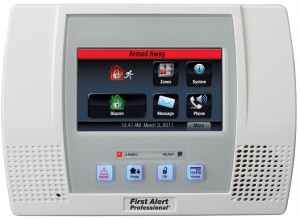 A huge red flag for criminals is a burglar alarm. Not because they are worried about the police arriving, because that usually takes 15-20 minutes under the best of circumstances. Instead, they’re worried about the loud alarm that’ll alert the neighbors and create witnesses. If you have an alarm company, great!
A huge red flag for criminals is a burglar alarm. Not because they are worried about the police arriving, because that usually takes 15-20 minutes under the best of circumstances. Instead, they’re worried about the loud alarm that’ll alert the neighbors and create witnesses. If you have an alarm company, great!
Get a couple of their signs and place one at the entryway to your property, and the other near the front door. Place a burglar alarm sticker on your rear door as well. If you can bear the unsightly things, place stickers on all of your ground floor windows so there’s no way an intruder can possibly miss them.
You don’t have an alarm company or cannot afford one? No problem! The signs and stickers themselves are the deterrent and there’s no reason you shouldn’t put them up. There are plenty of eBay shops selling fake burglar alarms, sensors and signs, just get one that is popular and well known in your area. Criminals know how to Google and will probably recognize your sign as fake if you chose “Guardian America”, or “Best Security”. Choose a well-known company like Brinks or ADT.
Criminals aren’t dumb and often will look through windows and try to see window sensors – indicating a “live” system. The burglar alarm control panel is oftentimes adjacent to the front door to make it convenient for the homeowner to activate and disable the system easily. If you opt for a fake system you’ll probably want to install dummy sensors on your windows as well as a fake control panel that’s visible from the front window. The fake controller often has a blinking LED powered by a battery, making you think it’s actually doing something. There are also battery powered fake motion sensors that do nothing more than flash an LED every 15 seconds. Another interesting product available on Amazon is a laser scanner that projects sweeping red laser beams around the room. A bit over the top perhaps, but would YOU break into that house?
Still, consider installing a legitimate alarm system that notifies the authorities (fire, police), sounds a local alarm, and continues to work during power outages. Many companies offer free installation of wireless sensors for doors, windows and breaking glass and charge a nominal monthly fee. The cost is often offset by reduced home insurance rates.
Motion & Thermally Triggered Spotlights
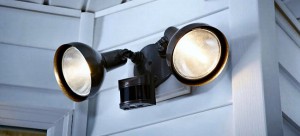 Not all break-ins occur during the day so having some form of lighting around the outside of your house will be a deterrent.
Not all break-ins occur during the day so having some form of lighting around the outside of your house will be a deterrent.
In urban neighborhoods where homes are very close together your neighbors would probably be upset with your high intensity light shining into their bedroom. To avoid this, let you neighbor know you’re installing a motion or thermal sensing light that only comes on when a human-sized target enters its field of view. He’ll probably appreciate that you’re supplementing his security as well as yours. Also, it’s nice to know that when the light is activated BOTH homeowners are looking out the window to see what triggered the lights. Motion and thermal sensor lights are easily installed and cost around $25, so you can put one on each corner of your home for $100.
Surveillance Cameras
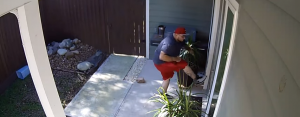 Nobody wants to be caught on camera breaking into a home, so surveillance cameras are a powerful deterrent.
Nobody wants to be caught on camera breaking into a home, so surveillance cameras are a powerful deterrent.
Camera technologies have advanced tremendously in the past few years so that even high resolution, low light CCDs cost less than $20. Most electronics stores sell WiFi surveillance systems, complete up to a dozen HD cameras, a DVR and armored case for $500-$800. You can install one of these systems in a single afternoon, providing video coverage of your entire property. The cameras are weatherproof, operate in very low light conditions, and capture high resolution (1080HD) images. The cameras can be programmed to record full time, or only when they detect movement to conserve space on the DVR. If you install one of these systems be sure to locate your DVR in its armored box somewhere that it’s difficult to find. It would be a shame to record the intruders, only to have them steal the DVR containing the evidence.
If you can’t afford the cost of a real system, there are many security shops on eBay and Amazon that sell fake surveillance cameras. These are usually battery powered with a blinking LED to simulate a recording camera.
Dogs
Intruders hate dogs because they never know how the animal will react to their entry. Barking dogs attract attention of witnesses, could possibly attack, may simply jump up and down on you, or may simply bolt through door for freedom. None of these works out well for an intruder, so homes thought to contain animals are typically avoided as high risk.
Allergic to dogs (or just don’t want one?). No problem. All you need to do is put out clues that your house contains a large dog. These may include water and food bowls, a large hair-covered bed, leather chew toys, or a leash lying outside the front door. The intruder may not hear the dog but will probably assume there’s one inside sleeping. If you choose to put out bowls just make sure to add water to one of them occasionally to maintain the facade of realism.
Front, Back, and Basement Doors
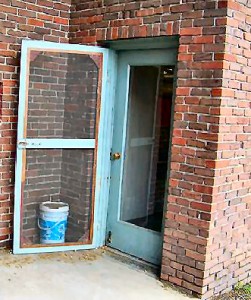 It’s amazing how some people harden up their front door with deadbolts, steel frames, and exotic locks yet have hollow core doors with junky locks on all their other doors. Do a walk around of your home and pretend you have lost your keys. How would YOU get in? Whatever way you choose is what you need to harden up in some way. Let’s start with the doors, ALL doors. They should ALL be EQUALLY strong.
It’s amazing how some people harden up their front door with deadbolts, steel frames, and exotic locks yet have hollow core doors with junky locks on all their other doors. Do a walk around of your home and pretend you have lost your keys. How would YOU get in? Whatever way you choose is what you need to harden up in some way. Let’s start with the doors, ALL doors. They should ALL be EQUALLY strong.
Doors should be fire rated for at least 20 minutes, have an insulated core, and be covered with a minimum of 24 gauge steel. Pictured is a full glass side entrance with only a simple key-in-knob lock. Intruder delay time: less than 3 seconds…
Install a peep hole so you’ll be able to who’s at the door before you open it. Most doors come pre-hung on a frame which should also be steel covered. The door should not have windows or glass. If you insist on glass, it should be double pane located high enough up to prevent someone from breaking the glass and reaching in to unlock the door. When your doors are attacked, the point where the door jamb attaches to the frame is the weakest point. When installing the pre-hung door take special care to solidly attach the door jamb to the frame in at least six points. The bolts should extend a minimum of 4” into the framed doorway.
The door should have a minimum of three hinges, each with screws long enough to pass through the door jamb and solidly into the frame.
The locks we already talked about… but there’s SO much more to keeping your door secure than just the locks. No matter which lock you choose, the lock set (door handle, and bolt that extends into the frame) is even MORE important. The strike plate on the door needs to be securely screwed through the door jamb and into the frame, using screws long enough to reach solid wood. The lock set should wrap around the door to reinforce against splintering if attacked. Many higher quality doors also have a steel reinforcement along the length of the door jamb to protect it from failing in a kicking attack. If you have an older home there are retrofit “armor kits” to toughen up your doors at a low cost while still complying with your HOA bylaws.
The likelihood that intruders will attack the door on the front of your house, in full view of the street and witnesses, is low. Statistically, 82% of break-ins occur on “other” doors. These include back or side doors, and basement doors where the attacker has more time to work unobserved. Recognizing these are your high risk entry points it makes sense to put additional effort into securing them.
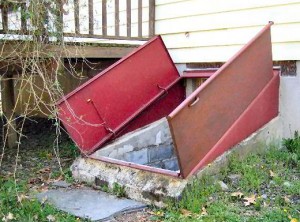 Ideally, install ornamental wrought iron steel doors on all of your home’s entry points instead of the traditional aluminum framed storm doors. These steel doors often look like normal storm doors but with a much higher level of security. Many people don’t like the appearance of these on their front doors but give them serious consideration for all other out-of-sight doors.
Ideally, install ornamental wrought iron steel doors on all of your home’s entry points instead of the traditional aluminum framed storm doors. These steel doors often look like normal storm doors but with a much higher level of security. Many people don’t like the appearance of these on their front doors but give them serious consideration for all other out-of-sight doors.
The wrought iron outer doors should have the same high quality lock as the main door and be keyed the same. On rarely accessed doors, like basement doors, consider a drop-in crossbar on the top and bottom of the frame. This will immunize them against kicking attacks if the attacker manages to get past your wrought iron door.
If you install security cameras, make sure you orient them to include views of all of your doors. Remember that the clock for the intruder starts the moment they enter your property. The longer you can delay them with physical layers and stress them with psychological layers, the quicker they’ll give up and leave. Cameras create tremendous psychological stress.
Windows and Casements
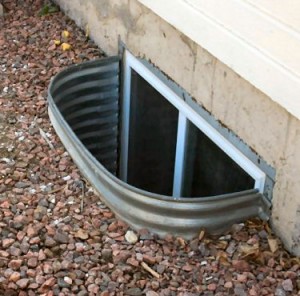 Windows and casements are excellent entry points into a home. Make it a practice to never open ground level windows from the bottom, as is normally done. If you want fresh air on the ground level, pull down the top portion of the window instead of raising the lower portion. This doesn’t prevent an intruder from climbing into the window, but it does make it much more difficult. An alternative is to limit the amount the window can open with a stop mechanism. Most windows today have this security tab that you can flip out, limiting the window to opening about eight inches. If you have an older window without this feature it’s an easy modification. Simply open the window about eight inches and drill a hole through the frame of the window. Be careful not to drill all the way through! Once you have drilled the hole, slide in a screw or steel dowel to prevent the window from being raised any further.
Windows and casements are excellent entry points into a home. Make it a practice to never open ground level windows from the bottom, as is normally done. If you want fresh air on the ground level, pull down the top portion of the window instead of raising the lower portion. This doesn’t prevent an intruder from climbing into the window, but it does make it much more difficult. An alternative is to limit the amount the window can open with a stop mechanism. Most windows today have this security tab that you can flip out, limiting the window to opening about eight inches. If you have an older window without this feature it’s an easy modification. Simply open the window about eight inches and drill a hole through the frame of the window. Be careful not to drill all the way through! Once you have drilled the hole, slide in a screw or steel dowel to prevent the window from being raised any further.
Many homes have casement windows or window wells installed to allow light into the basement. These are ideal entry points because once the intruder drops down into the sunken casement, he can work on the weak window completely unobserved. Even the sounds of breaking glass are muffled since it’s below ground level. Modifying these windows with steel pins or limiters will not reduce the risk.
The only way to harden up casement windows is by installing wrought iron bars on the outside. Fortunately, casement windows have standard sizes and pre-made wrought iron kits are available at a reasonable cost, usually around $100 each.
Sliding Glass Doors
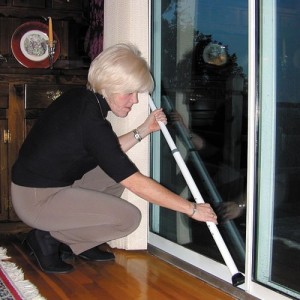 Sliding glass doors are the enemies of security specialists. Most are poorly designed and easy to defeat or bypass by lifting them off their tracks or breaking their inferior locking mechanisms. If you have sliding glass doors there’s very little you can do to harden them up.
Sliding glass doors are the enemies of security specialists. Most are poorly designed and easy to defeat or bypass by lifting them off their tracks or breaking their inferior locking mechanisms. If you have sliding glass doors there’s very little you can do to harden them up.
If it any consolation, they are very dangerous to break without injuring yourself. I’ve seen over a hundred break-ins where the thief shattered glass door and about 90% of them end up cut, leaving a lot of forensic evidence behind. In one memorable case a thief hit the glass with a claw hammer. The glass shattered and fell onto his arm and leg, severing the tendons in his wrist and severely cutting his upper leg.
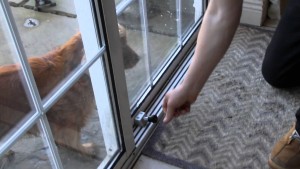 The blood trail was easy to follow and we found him in the woods in the rear of the property. In another case the thief threw a convenient deck chair through the window. The shattered glass particles hit him in the face, permanently blinding him in one eye. Neighbors heard his screams of pain and called 911. He was still lying on the deck screaming when the police arrived.
The blood trail was easy to follow and we found him in the woods in the rear of the property. In another case the thief threw a convenient deck chair through the window. The shattered glass particles hit him in the face, permanently blinding him in one eye. Neighbors heard his screams of pain and called 911. He was still lying on the deck screaming when the police arrived.
To make it a little more difficult to bypass these doors you can either wedge a piece of dowel into the frame to prevent the door from sliding, or install some sliding bolts on the frame to lock it in place. Aside from those simple hardenings, there’s only one more thing you can do to slow down an intruder:
Hurricane/Blast Film
Hurricane window film is some amazing stuff. It’s 7 or 8 mil thick and is easy to install on all of your windows and sliding glass doors. It was designed to stop debris thrown up by hurricanes and does an outstanding job of it. When applied to a window, it’s virtually shatterproof. When struck the glass does break but the hurricane film holds the fragments in place, shedding very few pieces. Even an attacker equipped with a baseball bat has a hard time breaking through the protected glass. The film just holds everything together and takes a heck of a beating before yielding. The U.S. Government has installed this (they call it “blast film”) on all glass in government buildings as protection against the effects of bomb attacks.
Hurricane film is cheap, costing only $150 to cover all windows and storm doors in the average home. You can apply it yourself in a single afternoon. It’s totally transparent, allows in about 70% of the available light, reflects 60% of the heat and rejects 97% of the infrared rays. It’s awesome stuff and a bargain of a security upgrade.
Other Openings
There are a number of other ways criminals can enter your home, some not so obvious. I have seen them enter through pet doors and air vents. It isn’t uncommon for criminals to use a homeowner’s own ladder against him. Ladders are bulky, cumbersome things so many people leave them stacked alongside the garage or behind the house. Of course, this is exactly what the burglar needs, thank you very much.
Storm cellars are another common entry point and are mostly left unlocked. I had a case where a criminal entered the storm cellar and cut through the wood floor to enter the main house. He used the homeowner’s electric tools that had been stored in the cellar. Oh yeah, he stole most of the tools too.
One last oddity. One burglar climbed up a rose-covered trellis to an upstairs balcony to enter through a sliding glass door into the bedroom. The owners were home, unfortunately for the 19 year old burglar. She screamed and the burglar ran back to the balcony and swung over to climb down. His hands were covered with blood from climbing through the roses so he lost his grip and fell to the ground, breaking his hip and upper arm. Still not giving up he tried to crawl away while the woman was screaming. The husband heard his wife, assumed the worst and grabbed a loaded 20-gauge shotgun. As he exited the garage the burglar saw him and made one last attempt to get up while supporting his weight on a tree. The homeowner, believing the burglar had attacked his wife and that his life was in danger, fired and hit the burglar’s legs from 15 yards away. The only positive thing out of this whole story is that the shotgun was loaded with birdshot, not buckshot. Still, it was a bad day to be a burglar… The doc later pulled 38 pieces of #8 shot out of his legs. Then he went to jail.
Landscaping
Landscaping is almost mandatory around our homes but too much of it can provide concealment for intruders. When planting your greenery try to keep the area around casements, in front of windows, and directly adjacent to doors clear. This deprives intruders of places to hide or lay in wait for you to approach the door.
When preparing their defensive positions, the military minimizes the amount of greenery in their “fields of fire”, which we are calling our “detection zone”. We have the same objective; defend the “interior zone”, so taking a play from their 200+ years of experience seems the prudent thing to do. So next up: your Interior Zone.